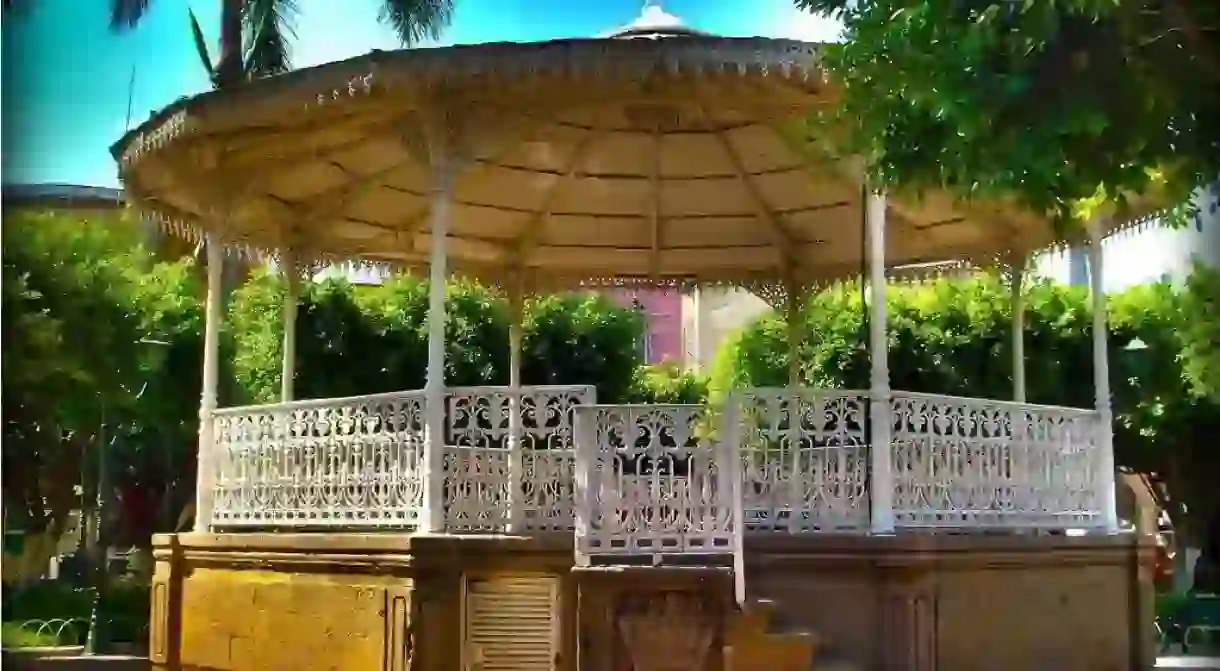A Walk Through Mexico's Kiosks in 16 Beautiful Photos

The tradition of having a central town gazebo, or kiosco, dates back to the construction of Mexico’s cities during Spanish colonization. Today, Mexico is just as proud of its kiosks as it was 500 years ago—from the country’s beach towns to its big cities, opulent and ornate kiosks can be found that serve as a reminder of each town’s unique traditions and history.
Ixtlahuacán de Río, Jalisco
On Sundays after mass, the town bands plays in this lovely gazebo in Ixtlahuacán de Río, Jalisco.

Chignahuapan, Puebla
This moorish style bandstand is the only one in Mexico made completely of wood. The fountain underneath the main structure charmingly reflects the gazebo’s waning quarter moon.

Colima, Colima
The Colima Kiosco sits in the main plaza along with the Catedral Basílica Menor, the Palacio de Gobierno, and the Colima Regional History Museum.

Guadalajara, Jalisco
The gorgeous wrought iron craftsmanship of this kiosco comes from the French La Val d’Osne company and was shipped across the ocean in pieces to be reassembled in Guadalajara.

Tingüindín, Michoacán
This lovely bandstand sits in the middle of the tiny town of Tingüindín, home to many avocado farmers. Visit the city during its celebration of la Ascensión de la Virgen María to really see the kiosco in all its splendor.

Gutiérrez Zamora, Veracruz
Breezy and beachy, the metallic underside of this gazebo will contort your facial features, making for a great photo.

Coyoacán, Mexico City
French in its architectural style, this gazebo was donated by Porfirio Díaz in 1900 to celebrate 100 years of Mexican independence.

San José Huipana, Michoacán
This colorfully decorated kiosco serves a population of less than 3,300 inhabitants in the far north of Michoacán.

Chiapa de Corzo, Chiapas
An important piece of colonial architecture in Mexico, this moorish kiosco was built by a Dominican monk in 1562 and is lovingly called La Pila by locals.

Tlaxcala de Xicohténcatl
This bandstand sits in the Plaza de la Constitución of Tlaxcala de Xicohténcatl, home of the first diocese of New Spain and an important socioeconomic center during Colonial times.

Mexico City, Mexico
The Kiosco Morisco moved around the city quite a bit before settling in Colonia Santa María de Ribera and was originally built to serve as the Mexican Pavillion at the New Orleans Universal Cotton Exposition from 1884-1885, and at the St. Louis, Missouri Fair in 1904.

Ciudad Guzmán, Jalisco
This gazebo, built in 1982, is said to have been the final work in the life of architect Vicente Mendiola Quezada, who also designed the Palacio Municipal of Guadalajara, and the Rotonda de los Jaliscienses Ilustres.

Cocula, Jalisco
This bandstand sits in the heart of the home of mariachi music, where many of the most famous mariachis in Mexico have been born.

Autlán de Navarro, Jalisco
This beautiful and delicate gazebo sitting in the Plaza Hidalgo is over 100 years old and made of wrought iron and cantera stone.

Temamatla, Mexico State
The ancient people of Temamatla worshipped the god of fertility and death, Xipe Totec, relics and ruins of which have been found, leading archeologists to believe that Temamatla’s people were great astronomers.

Tula, Tamaulipas
Tula is the oldest city in Tamaulipas and may have been home to one of oldest genetic lineages in the Americas. In 2011, the city was named a Pueblo Mágico.














